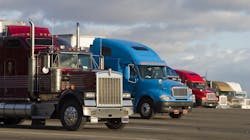Begin the new year with an operational reassessment
From the look of things, the U.S. economy will only grow at a slow pace in 2023. The Equipment Leasing & Finance Foundation is predicting economic growth at 0.9% and believes it is possible for there to be a recession beginning in the second or third quarter.
Regardless of economic conditions, the beginning of a new year is always a good time to re-evaluate processes and procedures to try to improve efficiency. It is important to take a long hard look at the way you operate.
Due to all the ongoing delays in new equipment deliveries, it will be more important than ever to determine if you have the right mix of trucks to achieve your 2023 business plan. Over the past three years, there has been a significant shift to e-commerce and an increased emphasis on last-mile delivery. You may find that by utilizing some of your older equipment to fill these lanes, you could increase your capacity and revenue.
See also: Making service decisions for older assets
To right size or reallocate your fleet, take an inventory of all assets. Determine the Total Cost of Ownership (TCO) for each asset and then deploy them in the most cost-effective and efficient lanes. Because the industry is extending asset life cycles, it is critical that we pay close attention to the ongoing running costs. Extended life cycles will require additional maintenance and preventive maintenance frequency will increase. Using older assets on routes that are closer to your shop will allow you to avoid costly roadside repairs.
TCO and utilization will be two key components of a successful asset redeployment strategy. Once you have your assets assigned to the most cost-effective and efficient lanes, you must look at two key components of utilization. First, miles driven, and second—but just as important—loaded miles. In the case of diminishing load deliveries, is there an opportunity for backhaul at the end of the route? Loaded miles are how fleets can drive additional revenue and cut costs.
Data analysis and TCO tracking frequency also will need to increase along with maintenance intervals to make these changes effective. This heightened analysis will prove to be useful in both the short term and long term making us all more efficient in how we operate our fleets.
Patrick Gaskins, SVP of Corcentric Fleet Solutions, oversees both sales and operations for the company's fleet offerings. Gaskins joined the company in 2010, bringing more than 30 years of experience as a financial services professional in the transportation industry. He leads a team that works with a supply base of more than 160 manufacturers to help the country’s largest fleets manage all aspects of their fleet operations and fleet-related spend.
About the Author

Patrick Gaskins
Senior vice president, Fleet Solutions
Pat Gaskins is the senior vice president of Corcentric Fleet Solutions, where he leads both the sales and operations teams for the company’s fleet offerings. He has over 30 years of experience as a financial services professional in the transportation industry and manages partnerships with over 160 manufacturers, helping over 2,000 of the country’s largest fleets manage all aspects of their fleet operations and fleet-related spend.
